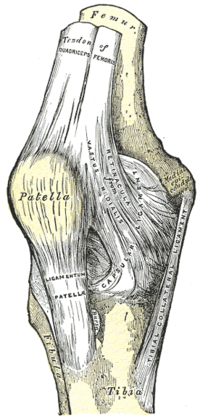
Photo from wikipedia
Purpose Free quadriceps tendon autograft (QTA) has gained popularity for both primary and revision ACL reconstruction. The aim of this study is to measure the dimensions of quadriceps tendon and… Click to show full abstract
Purpose Free quadriceps tendon autograft (QTA) has gained popularity for both primary and revision ACL reconstruction. The aim of this study is to measure the dimensions of quadriceps tendon and determine its correlation with patient’s height, weight and BMI. This is to provide a guide for patients and surgeons in predicting the suitability of QTA for ACL reconstructions. Methods A cross-sectional study in which the length and thickness of the quadriceps tendon was measured in 51 Caucasian patients who underwent primary total knee arthroplasty. Exclusion criteria include non-Caucasians and previous tendon pathology. Patients were selected from routine elective total knee arthroplasty list. Tendon length is taken from musculotendinous junction to its insertion. Thickness was measured at midpoint and at distal insertion. Patients’ height, weight and BMI were recorded. The correlation between patient physical parameters and tendon dimensions were determined. Results Subjects’ median age was 65 years (range 44–87), with 34 females and 17 males. Median length of the tendon was 9 mm (range 70–110), and median insertional thickness was 9 mm (7–10 mm). Median thickness at midpoint was 7 mm (range 4–10 mm). There was moderately positive correlation between subjects’ height and tendon length (correlation coefficient 0.50), and also between weight and tendon length (correlation coefficient 0.47). There was no significant correlation between subjects’ BMI and the tendon length. There was also no significant correlation between tendon thickness and subject’s physical parameters. Conclusion This study has shown that most patients could provide adequate QTA for ACL reconstruction. It also points to the fact that no investigation is required to predict the adequacy of QTA. Though further studies with larger sample size are required to confirm this, clinician can rely on analysing patients’ physical parameter in predicting the adequacy of QTA for ACL reconstruction. Level of evidence II.
Journal Title: Knee Surgery, Sports Traumatology, Arthroscopy
Year Published: 2019
Link to full text (if available)
Share on Social Media: Sign Up to like & get
recommendations!